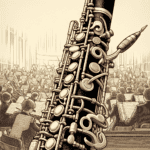Welcome to your ultimate guide on clarinet hacks! Whether you're just starting out or already on your musical journey, these tips and tricks will make your playing experience smoother and more enjoyable. From keeping your clarinet in top shape to mastering playing techniques, we've got you covered. Let's get started!
Choosing the Right Clarinet
Your journey begins with picking a clarinet that fits your needs. The Martin Freres brand offers a variety of clarinets for both beginners and pros. When choosing, think about the material (wood or plastic), the key system (Boehm or Oehler), and the overall build quality. A well-made instrument can really make a difference in how you play.
Proper Maintenance
Taking care of your clarinet is key to keeping it in good shape and sounding great. Here are some tips:
- Regular Cleaning: Always swab your clarinet after playing to get rid of moisture. This helps prevent mold and keeps your pads lasting longer.
- Key Oil: Apply key oil to the mechanism now and then to keep it moving smoothly.
- Mouthpiece Care: Clean your mouthpiece with warm water and a mouthpiece brush. Avoid hot water as it can warp the mouthpiece.
Reed Selection and Care
Reeds are super important for your sound. Here's how to pick and care for them:
| Aspect | Tip |
|---|---|
| Reed Strength | Start with a softer reed (2 or 2.5) and move to harder ones as your embouchure gets stronger. |
| Rotation | Rotate between multiple reeds to make them last longer and keep your sound consistent. |
| Storage | Store your reeds in a reed case to ensure they dry evenly and don't warp. |
Improving Your Embouchure
Your embouchure (how you shape your mouth and lips around the mouthpiece) is crucial for sound production. Here are some tips to improve it:
- Practice Long Tones: Playing long tones helps you focus on your embouchure and breath control.
- Use a Mirror: Practice in front of a mirror to make sure your embouchure is consistent.
- Relax: Don't bite down on the mouthpiece. Your embouchure should be firm but relaxed.
Finger Technique
Good finger technique is essential for smooth playing. Here are some exercises to improve it:
- Scales and Arpeggios: Practice scales and arpeggios daily to build finger strength and dexterity.
- Slow Practice: Slow down tricky passages to make sure each note is clean and precise.
- Use a Metronome: Practicing with a metronome helps you develop a steady rhythm and timing.
Breath Control
Good breath control is key for producing a rich, full sound. Here's how to improve it:
- Breathing Exercises: Practice breathing exercises to increase your lung capacity and control.
- Diaphragmatic Breathing: Focus on breathing from your diaphragm rather than your chest.
- Long Tones: Incorporate long tones into your practice routine to work on sustaining notes.
Intonation and Tuning
Keeping your clarinet in tune is vital for playing in groups. Here's how to improve your intonation:
- Tuner Use: Use an electronic tuner to check your intonation regularly.
- Listen: Develop your ear by listening carefully and adjusting your pitch as needed.
- Barrel Adjustment: Adjust the barrel of your clarinet to fine-tune your overall pitch.
Troubleshooting Common Issues
Every clarinetist faces issues now and then. Here's how to troubleshoot some common problems:
| Issue | Solution |
|---|---|
| Squeaks | Check reed placement, embouchure, or finger position. Experiment with adjustments to find the cause. |
| Sticky Keys | Clean your keys regularly and use a small amount of key oil to keep them moving smoothly. |
| Air Leaks | Check for air leaks by covering all the tone holes and blowing into the instrument. If you feel air escaping, you may need to replace pads or have adjustments made by a professional. |
Advanced Techniques
Once you've got the basics down, you can start exploring advanced techniques to further enhance your playing:
- Overtones: Practice producing overtones to improve your control and range.
- Glissando: Learn to perform glissandos for a smooth, sliding effect between notes.
- Double Tonguing: Work on double tonguing to increase your speed and articulation.
Learning to play the clarinet is a rewarding journey. With the right techniques and consistent practice, you can master this beautiful instrument. Remember to enjoy the process and keep exploring new ways to improve your skills. Happy playing!







